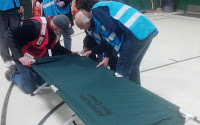Shelter Simulation Training
Q: How many shelters have you worked in?
A: I have supported nearly a dozen disaster shelters. When a disaster occurs, I receive notification and support the sheltering process by identifying potential shelter facilities, providing technical guidance to the on-scene shelter leadership, and coordinating response activities.
Q: What exactly is a shelter simulation?
A: There are a number of reasons that we do shelter simulations. 1) To provide our staff with hands-on practice so that they are better prepared to perform the activities when a disaster occurs. 2) To give our volunteers an opportunity to experience real-world challenges they will be facing during a disaster without the stress of a disaster. 3) It allows the Red Cross an opportunity to collaborate with other response organizations (such as the Medical Reserve Corps) to address specific needs of shelter residents. 4) Most importantly, it is fun!
Q: What is biggest misconception about running/opening a shelter?
A: One of the largest misconceptions about sheltering is that the community thinks that Red Cross designates shelter facilities.This isn’t the case in Oregon. We have a list of potential shelter facilities that we may call and ask permission to use as a disaster shelter. The facilities we use as shelters are not owned by the Red Cross, they are facilities such as churches, community centers, or in some cases schools. When the Red Cross asks to use a facility, the facility owner may say no if there is a conflict. It is really important that individuals and families develop a disaster plan, have supplies, and stay informed about how they can prepare and respond when a disaster occurs.
Q: I have heard that the Red Cross doesn’t shelter pets, what should I do?
A: In most communities, the Red Cross works with animal welfare groups to ensure that shelter residents have a place for their pets. This varies in chapters across the country so always be thinking ahead. C heck with family members or friends to see if they can care for your animals if you are displaced from your home. If you cannot find someone to take care of your animals and you are required to evacuate, evacuate your animals with you. As you developyour disaster supplies kit, make sure you include supplies for your animal(s) as well. When you arrive at a Red Cross shelter with animals let the shelter staff know that you have animals so that they can contact groups such as animal services or other agencies that have the expertise and trained staff to shelter the animals.


5 comments
Great way to publish the news. I like this creative blog post. Thanks for distributing such a great stuff.
Cappadocia tours
The training will help a lot in the future if needed.
The simulation will help them to be ready in times of calamity.
This training is good for everyone for self preparedness…
In this essay I will consider the social, economic and political factors of Disaster Kit. In depth analysis of Disaster Kit can be an enriching experience. Indispensable to homosapians today, Disaster Kit is not given the credit if deserves for inspiring many of the worlds famous painters.disaster supplies
Comments are closed.